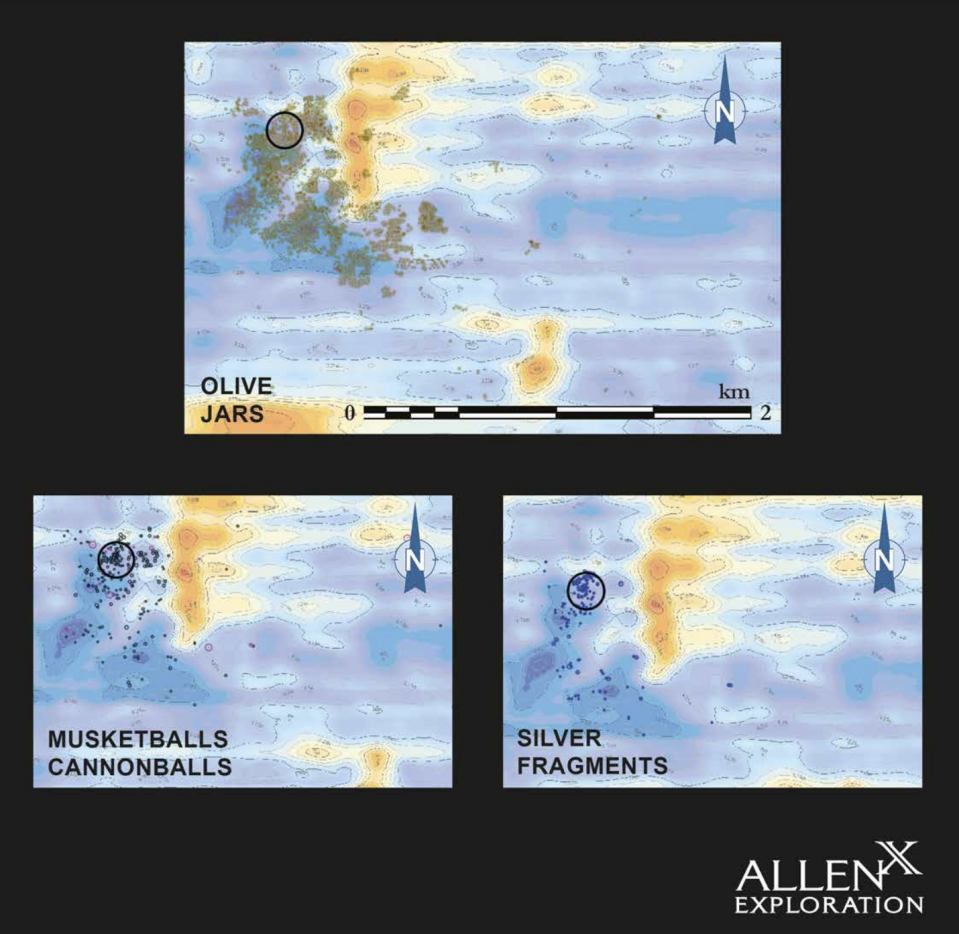After years of careful exploration, divers have helped map a trail of scattered artifacts and treasures stretching more than two miles in the waters off the Bahamas that has drawn archaeologists and adventurers for centuries to search for the remains of a legendary shipwreck.
Nuestra Señora de las Maravillas, a Spanish treasure ship, sank near the Bahamas in January 1656 after colliding with another ship. Treasure hunters have been scouring the area ever since in search of the ship’s lost cargo, and some historians estimate that approximately 5 million pesos worth of silver bullion, coins, and wrought silver were recovered from the site between 1656 and 1683. Major exploration and recovery projects The wealth of relics found by adventurer Robert Marx in 1972 was particularly remarkable among modern treasure hunting expeditions in that region.
“Some people claim this was one of the richest Spanish galleons ever sunk in the New World,” said Michael Pateman, curator of the Bahamas Maritime Museum in Freeport. “CBS Mornings” In April. Marine archaeologist Jim Sinclair insisted in the same interview that the lost ship’s main treasure hoard had yet to be found, saying: “We’re probably looking at more than $100 million sitting on the sand here.”
The Bahamian government declared a moratorium on salvage expeditions in 1999 after numerous artifacts recovered from the wreck ended up in auctions and private collections around the world. But in 2019 the government lifted that moratorium to grant AllenX, formerly Allen Exploration, a license to explore what was left.
With the license, the company began searching the waters west of Little Bahama Bank for the remains of the 891-ton two-deck Spanish galleon. Remote sensing surveys and physical diving teams have so far identified a huge trove of artifacts radiating from an original spot near where Maravillas crashed into a reef on January 4, 1656.
AllenX identified nearly 8,800 items of “potential cultural significance,” the company said in a new report detailing the findings. The Maravillas treasure trail is stated to extend almost 3 1/2 kilometers, or just over 2 miles, from the main ballast pile, which was first discovered in the 1970s, and the area is described as being about a mile wide. A ballast pile is a pile of stones once stored in a ship’s hold to stabilize a ship in the water, which can provide clues to the location of a shipwreck.

The complex trail of scattered artifacts “consists of a wide variety of items ranging from loose gallstones, the occasional wooden plant, iron hardware, gun carriage concretes, and ceramics from two iron revolving cannons” that explorers and Bahamian officials deemed culturally significant. They include silver pesos, silver bars, emeralds, amethysts and gold jewelry,” the report said.
Today, the majority of Maravilla ruins are buried beneath layers of sand, some as deep as 1 1/2 miles; because they are hidden and spread across the ocean floor by waves and, in some cases, extreme weather events such as severe hurricanes over hundreds of years.
Under all that sand, explorers have identified thousands of objects that once came from the Maravillas, carefully mapping each item found. The remains include approximately 11,000 olive jar fragments, almost 3,000 silver coins, 828 lead musket balls and 125 emeralds and amethysts. Working under license from the government, AllenX recovered more than 10,000 artifacts from the Maravillas, many of which were found quite intact, including pendants, gold chains, silver ingots and crosses.


Contrary to what past explorers of the wreck site have shown, AllenX confirms in its latest report that “the Maravillas have not been forgotten” and adds that “significant archaeological remains have survived.”
“Not only did inherently significant artifacts overcome the challenges, but so did material assemblages of technological, socio-economic and religious significance,” the company writes. A number of items identified and mapped on Maravillas help understand what life on the ship was like; AllenX says two rotating guns were once placed on deck “to fire at attackers attempting to board or screen enemy ships at close range.” “


“Personal items and contraband from officer and passenger rooms were particularly common,” the report states. “These range from navigation equipment, Chinese porcelain and majolica from Seville and Pueblo in Mexico, which officers and passengers ate with silver forks, to gold and gem-studded jewelry, chest keys, swords, and smuggled emeralds and amethysts.”
What’s next for Rush?
Cary Grant: The man we thought we knew
Companies and countries fight to develop quantum computers | 60 minutes